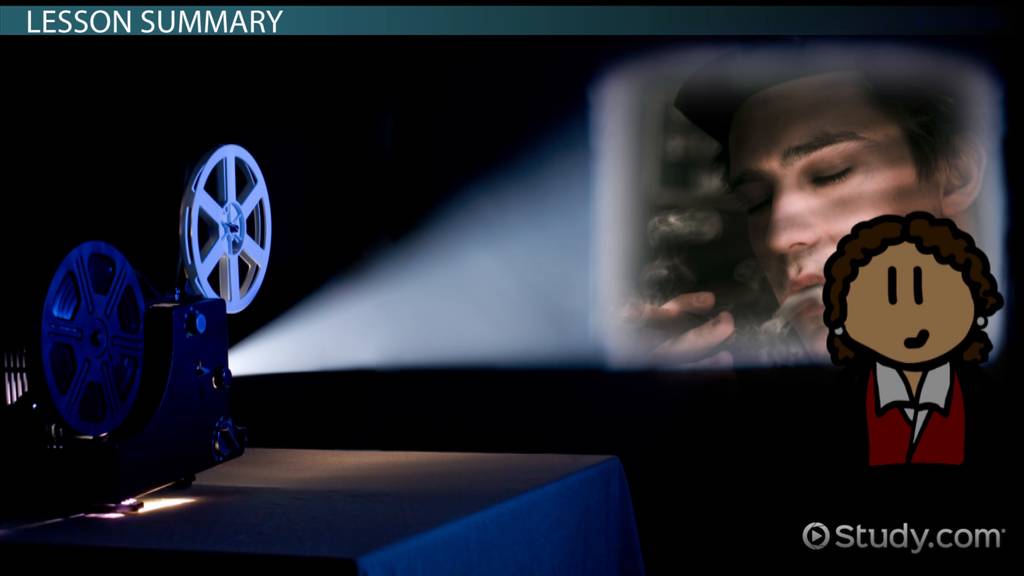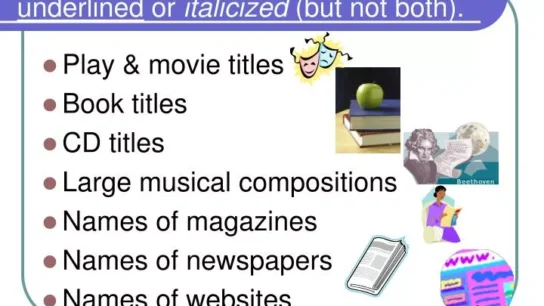Do You Italicize Movie Titles?
When it comes to writing, formatting can be just as important as content. One common question writers often have is whether movie titles should be italicized. This post will clear up any confusion and provide additional context on the subject, along with some related questions. We’ll also explore the history of formatting, the rationale behind the rules, and provide examples from different style guides.
Formatting Movie Titles Italicize Movie: The Basics
Italics vs. Quotation Marks
The general consensus among style guides is that movie titles should be italicized. This rule applies to most major style guides, including the Modern Language Association (MLA), the American Psychological Association (APA), and the Chicago Manual of Style.
Italics:
- Example: Inception is one of Christopher Nolan’s most acclaimed films.
Quotation Marks (AP Style):
- Example: “Inception” is one of Christopher Nolan’s most acclaimed films.
While italics are the preferred method for most academic and literary writing, the Associated Press (AP) Stylebook recommends using quotation marks for movie titles. This is primarily because italics were not feasible with early printing presses (Grammar Underground).
Related Article: Understanding Different Style Guides
Why Italics?
Italics are used to distinguish titles of larger works from the rest of the text. This includes books, movies, and television shows. Italics help to set these titles apart, making it clear to the reader that they are proper titles (UoPeople).
Related Article: How to Use Italics in Writing
Historical Context of Italics and Quotation Marks
The use of italics dates back to the Renaissance period when they were first introduced by the Italian printer Aldus Manutius in the late 15th century. Italics were initially used for emphasis and to distinguish certain types of text. Over time, their use evolved to include titles of larger works, such as books and movies.
Quotation marks, on the other hand, have been used in English writing since the 17th century. They were initially employed to indicate direct speech. Their use expanded to include titles of shorter works, such as articles, poems, and chapters.
The distinction between italics and quotation marks helps to provide clarity and structure in writing, making it easier for readers to identify different types of works.
Rationale Behind Formatting Rules
The primary reason for using italics for movie titles is to create a visual distinction between the title and the surrounding text. This helps to prevent confusion and ensures that readers can easily identify the title of the movie. Italics also add a level of formality and professionalism to the writing.
In contrast, quotation marks are used for shorter works or parts of larger works. This includes articles, short stories, poems, and episodes of TV shows. The use of quotation marks helps to indicate that these are smaller components within a larger context.
Examples from Different Style Guides
Modern Language Association (MLA)
In MLA style, movie titles should be italicized. This rule also applies to titles of books, plays, periodicals, databases, and websites.
- Example: In her essay, she analyzed the themes in The Godfather.
American Psychological Association (APA)
APA style also requires movie titles to be italicized. This formatting is consistent with the treatment of titles for books and other standalone works.
- Example: The study focused on the psychological impact of Black Swan on viewers.
Chicago Manual of Style
The Chicago Manual of Style recommends italicizing movie titles. This rule is part of a broader guideline for italicizing titles of major works.
- Example: In his review, he praised the cinematography of Blade Runner.
Associated Press (AP) Style
AP style is an exception to the rule. It recommends using quotation marks for movie titles, primarily due to historical reasons related to early printing technology.
- Example: The article discussed the cultural significance of “Pulp Fiction.”
Related Article: How to Format Titles According to Different Style Guides
Q&A: Common Questions About Movie Title Formatting
Q1: Are movie titles italicized or in quotes?
Movie titles are typically italicized. However, the AP Stylebook prefers using quotation marks. For example, The Godfather (italics) in most writing styles versus “The Godfather” (quotes) in AP style (Grammar Underground).
Q2: Do I italicize movie titles in MLA?
Yes, in MLA style, movie titles should be italicized. This also applies to titles of books, plays, periodicals, and websites (IRSC Libraries).
Q3: Are movie titles italicized in APA style?
Yes, in APA style, movie titles should be italicized. This is consistent with the formatting rules for titles of books and other standalone works (Baker College).
Q4: What about movie titles in dialogue?
When mentioning movie titles in dialogue, they should still be italicized if they are standalone works. Shorter works, such as episodes of a TV series, should be placed in quotation marks (Writing Stack Exchange).
Related Article: How to Format Titles in Dialogue
Q5: How should movie titles be formatted in academic papers?
In academic papers, movie titles should generally be italicized. This rule applies to MLA, APA, and Chicago styles. However, always check the specific guidelines provided by your instructor or institution.
- Example in MLA: The paper explored the narrative structure of Inception.
- Example in APA: The research highlighted the themes in Fight Club.
Q6: How should I format movie titles in a bibliography?
In a bibliography, movie titles should be italicized. This helps to distinguish the titles from other elements in the citation.
- Example in MLA: The Matrix. Directed by Lana Wachowski and Lilly Wachowski, Warner Bros., 1999.
- Example in APA: Wachowski, L., & Wachowski, L. (Directors). (1999). The Matrix. Warner Bros.
Q7: Do I need to italicize movie titles in digital content?
Yes, movie titles should be italicized in digital content, including blog posts, articles, and social media. This ensures consistency and professionalism in your writing.
- Example: In her latest blog post, she reviewed The Lord of the Rings trilogy.
Related Article: How to Format Titles in Digital Content
Practical Tips for Formatting Titles
Consistency is Key
Consistency is crucial when formatting titles. Always follow the same style guide throughout your document or publication. This helps to maintain a professional and polished appearance.
Use Style Guides
Refer to style guides for specific rules on formatting titles. The MLA Handbook, APA Publication Manual, and Chicago Manual of Style are excellent resources. These guides provide detailed instructions on formatting titles and other elements of writing.
Proofread Your Work
Always proofread your work to ensure that titles are formatted correctly. This includes checking for consistency and adherence to the chosen style guide. Proofreading helps to catch any errors or inconsistencies that may have been overlooked.
Utilize Word Processing Tools
Many word processing tools, such as Microsoft Word and Google Docs, offer formatting options for italics and quotation marks. Use these tools to format your titles correctly. Additionally, some writing software includes style guide templates, making it easier to format your work according to specific guidelines.
Examples of Correct Formatting
Example 1: Academic Paper (MLA Style)
In her analysis of The Great Gatsby, Smith explores the themes of wealth and love. She argues that the novel’s portrayal of the American Dream is both compelling and tragic. The film adaptation of The Great Gatsby, directed by Baz Luhrmann, captures the essence of Fitzgerald’s work.
Example 2: Blog Post (APA Style)
The recent release of Dune has sparked discussions about its adaptation from the novel by Frank Herbert. The film’s director, Denis Villeneuve, has been praised for his visionary approach. In this blog post, we will examine the key differences between the book and the movie.
Example 3: Newspaper Article (AP Style)
The new release of “No Time to Die” marks the final appearance of Daniel Craig as James Bond. Fans and critics alike are eager to see how the film concludes his tenure as the iconic spy. In this article, we will review the highlights of Craig’s Bond movies.
Special Cases and Exceptions
Titles Within Titles
When a title appears within another title, different formatting rules apply. The main title should be italicized, while the internal title should be placed in quotation marks.
- Example: The book Reading “Lolita” in Tehran explores the impact of literature in a restrictive society.
Foreign Titles
Foreign movie titles should be italicized, just like English titles. If the title is translated, the translation should be in italics, followed by the original title in parentheses if necessary.
- Example: The film La Dolce Vita (The Sweet Life) is a classic of Italian cinema.
Titles in Multiple Languages
If a movie title is known by different names in different languages, use the most recognizable title in italics. If necessary, provide the alternative title in parentheses.
- Example: The film Spirited Away (Sen to Chihiro no kamikakushi) is a beloved animated movie by Studio Ghibli.
Common Mistakes to Avoid
Mixing Italics and Quotation Marks
Avoid mixing italics and quotation marks for the same title. Choose one format and stick with it throughout your writing.
- Incorrect: The movie “Titanic” is a classic.
- Correct: The movie Titanic is a classic.
Overuse of Italics
While italics are useful for distinguishing titles, overusing them can make your text hard to read. Use italics sparingly and only when necessary.
Inconsistent Formatting
Inconsistent formatting can make your writing look unprofessional. Ensure that all movie titles are formatted consistently according to the chosen style guide.
- Incorrect: The movie Inception is a masterpiece, but “The Dark Knight” is his best work.
- Correct: The movie Inception is a masterpiece, but The Dark Knight is his best work.
Conclusion
When writing about movies, proper formatting is crucial for clarity and professionalism. In most cases, movie titles should be italicized, following the guidelines of major style guides like MLA, APA, and Chicago. However, AP style uses quotation marks due to historical reasons related to printing technology. Understanding these rules can help you present your writing in a polished and professional manner.
For more information on writing and formatting, check out our related articles linked throughout this post. Stay tuned for more tips and guides on effective writing!







